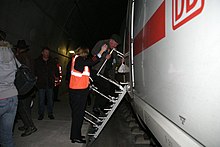Self rescue concept

The self-rescue concept ( abbr.SRK ) is an instruction for train attendants in the event of danger in the Deutsche Bahn network . The self-rescue concept is used in the event of danger, such as a fire on the train in a tunnel . The greatest possible emergency or danger is evacuating the train in a dangerous section of the route, for example in a tunnel or on long bridges.
So-called signal words are used by the train crew in an announcement that is not understandable for the passenger to inform internally about dangers and to initiate measures. Communication between the individual train attendants and the driver must also be guaranteed at all times. The long-distance passenger coaches operated by Deutsche Bahn are equipped accordingly. The driver must be able to inform the train crew on the train about disturbances such as B. to inform the pulling of the emergency brake . This can be done using special radios or via a loudspeaker system using signal words in the car. A functioning emergency brake override is also necessary, as is the presence of a special so-called emergency case, which is usually housed in the service compartment. This contains, among other things, a megaphone to inform passengers after getting off a train and two halogen lamps.
history
The self-rescue concept emerged from extensive considerations on tunnel safety that were started in the 1980s before the first new lines were put into operation in Germany. Until then, the network was predominantly characterized by short tunnels, but a number of tubes several kilometers long went into operation in the course of these new high-speed routes. So far, only limited precautions have been taken in the event of an incident for individual, longer tubes in the existing network, after around 30 years of no fatal accidents in a long-distance railway tunnel, a new discussion started.
In the safety considerations of the changed tunnel situation, on the one hand the low probability of occurrence (large track spacing, no station-specific dangers, etc.), but on the other hand also the higher potential damage caused by high-speed trains in long tunnels. At the beginning of the 1980s, the then Deutsche Bundesbahn awarded a methodical risk assessment to two engineering offices. For this purpose, a four-stage concept was developed, the first version of which was available in 1988:
- Event-preventing measures (e.g. segregation of passenger and freight traffic)
- Measures to reduce dimensions (in particular the introduction of the emergency brake override )
- Self-rescue measures
- External rescue measures (e.g. short attack routes, extinguishing water supplies, radio coverage, rescue stations)
Self-rescue measures include escape routes (including appropriate signs), tunnel lighting, emergency telephones, emergency exits, a scheme for carrying out self-rescue and training for operating personnel. The necessary measures are set out in the corporate policy on business continuity management . Train attendants receive (as of 1997) the procedures also in pocket format. Over time, on-site exercises have been replaced by training on the PC.
literature
- Hans-Heinrich Grauf, Franz Lennartz: The self-rescue concept for new lines . In: Die Bundesbahn , 64, No. 3, 1988, ISSN 0007-5876 , pp. 221-226.
Individual evidence
- ^ A b c Dieter Metz: Experience in the field of tunnel safety on German high-speed routes . In: Personal safety when operating long railway tunnels . Documents for a specialist conference at the ETH Zurich , October 17, 1997, pp. 73–80